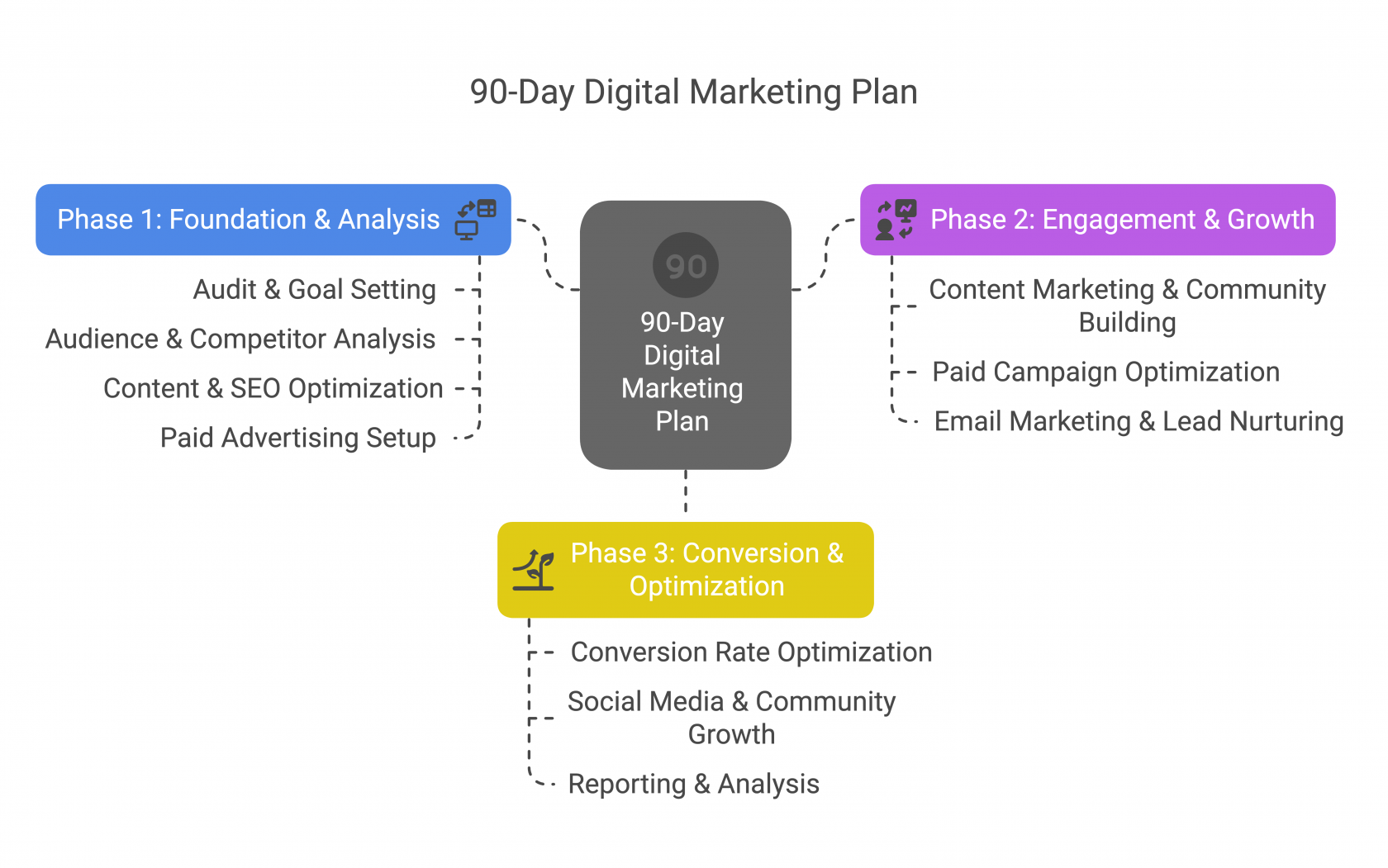90-Day Digital Marketing Plan
- Phase 1 (Days 1-30): Foundation & Analysis: This phase is about setting the stage for success. It involves auditing your current digital assets, defining clear goals, understanding your audience and competitors, optimizing your website for search engines (SEO), and setting up your paid advertising campaigns.
- Phase 2 (Days 31-60): Engagement & Growth: The focus shifts to actively engaging with your audience and building brand awareness. This includes implementing your content calendar, interacting with followers on social media, participating in online communities, and optimizing your paid campaigns based on early performance data. Email marketing and lead nurturing also play a key role.
- Phase 3 (Days 61-90): Conversion & Optimization: The final phase concentrates on driving conversions and maximizing your return on investment (ROI). This involves analyzing website performance and implementing conversion rate optimization (CRO) strategies, growing your social media community, and generating comprehensive reports to analyze your overall campaign effectiveness.
Throughout all phases, the plan emphasizes the use of essential digital marketing tools like Google Analytics, social media management platforms, and email marketing platforms. It also stresses the importance of strategic budgeting, clear team communication, and the flexibility to adapt the plan as needed.
In essence, this 90-day plan is a roadmap to help you systematically improve your digital marketing efforts, from initial setup and analysis to active engagement and long-term optimization.
Phase 1: Foundation & Analysis (Days 1-30)
Goal: Establish a strong foundation and gain insights for optimization.
Activities:
Week 1: Audit & Goal Setting
- Task 1: Conduct a comprehensive audit of current digital channels (website, social media, email).
- Task 2: Define clear, measurable, achievable, relevant, and time-bound (SMART) goals for the next 90 days.
- Task 3: Identify key performance indicators (KPIs) to track progress.
Week 2: Audience & Competitor Analysis
- Task 1: Refine target audience personas based on existing data and research.
- Task 2: Conduct a thorough competitor analysis to identify strengths, weaknesses, and opportunities.
- Task 3: Set up social listening tools to monitor brand mentions and industry trends.
Week 3: Content & SEO Optimization
- Task 1: Review and optimize website content for SEO, focusing on keyword research and on-page optimization.
- Task 2: Develop a content calendar for the next 60 days, focusing on high-value content.
- Task 3: Identify content gaps and create new content assets.
Week 4: Paid Advertising Setup
- Task 1: Set up or optimize paid advertising campaigns on relevant platforms (Google Ads, social media ads).
- Task 2: Define target audience segments for paid campaigns.
- Task 3: Develop ad creatives and landing pages.
Phase 2: Engagement & Growth (Days 31-60)
Goal: Drive engagement and build brand awareness.
Activities:
Week 5-8: Content Marketing & Community Building
- Task 1: Implement the content calendar, focusing on blog posts, social media updates, and email newsletters.
- Task 2: Engage with followers on social media, responding to comments and messages.
- Task 3: Participate in relevant online communities and forums.
- Task 4: Explore influencer marketing opportunities.
Week 6-8: Paid Campaign Optimization
- Task 1: Monitor paid campaign performance and make adjustments based on data.
- Task 2: A/B test ad creatives and landing pages to improve conversion rates.
- Task 3: Refine targeting based on campaign performance.
Week 7-8: Email Marketing & Lead Nurturing
- Task 1: Segment email list and develop targeted email campaigns.
- Task 2: Create lead magnets and implement lead nurturing workflows.
- Task 3: Track email open rates and click-through rates.
Phase 3: Conversion & Optimization (Days 61-90)
Goal: Drive conversions and optimize for long-term growth.
Activities:
Week 9-12: Conversion Rate Optimization (CRO)
- Task 1: Analyze website and landing page performance to identify areas for improvement.
- Task 2: Implement CRO strategies, such as A/B testing and user experience (UX) improvements.
- Task 3: Optimize call-to-action (CTA) buttons and forms.
Week 10-12: Social Media & Community Growth
Week 11-12: Reporting & Analysis
- Task 1: Generate comprehensive reports on campaign performance, focusing on KPIs.
- Task 2: Analyze data to identify trends and insights.
- Task 3: Develop recommendations for future campaigns.
Essential Tools:
- Google Analytics
- Social Media Management Platform (e.g., Hootsuite, Buffer)
- Email Marketing Platform (e.g., Mailchimp, Constant Contact)
- SEO Tools (e.g., SEMrush, Ahrefs)
- CRM (Customer Relationship Management) system (e.g., HubSpot)
Key Considerations:
- Budget: Allocate budget strategically across different channels and activities.
- Team: Assign responsibilities and ensure clear communication.
- Flexibility: Be prepared to adapt the plan based on performance data and changing market conditions.
This 90-day plan is a starting point. Tailor it to your specific needs and goals for maximum impact.


No Comments